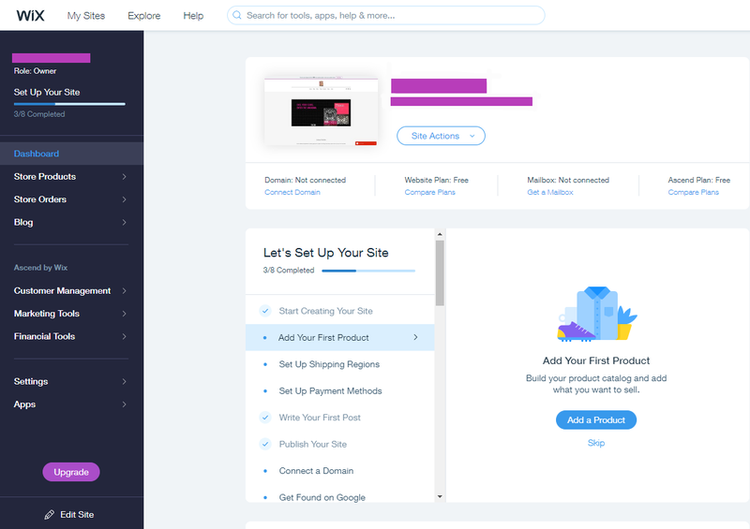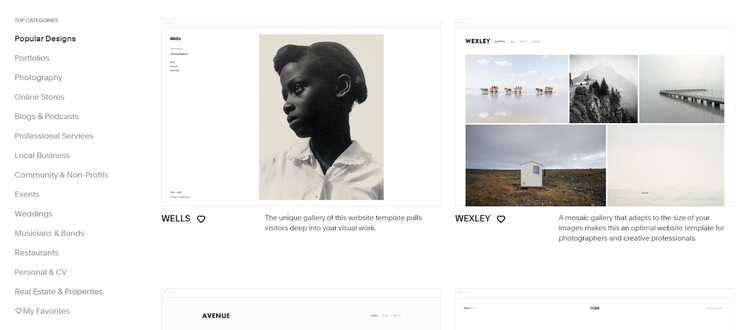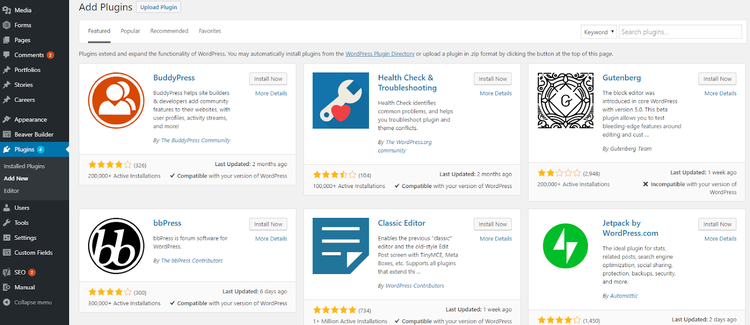As an artist, you want to spend your time creating art, not a website. Yet an artist website is the single biggest piece of marketing collateral for your artistic business.
A website showcases your artwork, makes it possible for people to discover you, and provides a means for patrons all over the world to contact you and buy your works.
Creating an artist website for yourself is possible for even the least technically savvy individual. This guide shows you how.
How to create an artist website
To make an artist website, use a do-it-yourself website service called a content management system (CMS). A CMS allows you to create and customize a website without any technical knowledge.
A user-friendly CMS is a low-cost alternative to hiring someone to build the site for you, and some, such as Bolt CMS, let you set up a free website.
Combine a portfolio-friendly CMS with the following steps, and you can build an artist website the way you want regardless of your skills or experience.
Step 1: Identify objectives
To start, determine your objectives for creating an artist website. Do you simply want to use the site as a digital portfolio of your work? Do you want to sell art online? Is the site intended for marketing purposes, too, such as announcing a gallery showing where patrons can view your art in person?
Your objectives will dictate what kind of website functionality is required. This allows you to look for the CMS that best fits your needs.
Tips for identifying objectives
You may know immediately part of what you want -- such as another venue through which you can showcase your works -- but other objectives may be murky. Here are some suggestions to help.
- Perform research: Research other art websites, such as those belonging to Gerhard Richter, Wim Delvoye, or other popular artists in your field. This can generate ideas for your own website, and it helps you identify the qualities that make for an appealing artist site.
- Create a features list: Brainstorm a list of features and content you want on your website. Then, prioritize the top three features that are most important to get you started. This exercise will help you narrow your focus so you can launch an initial version of your website in a timely manner.
- Start small: When you’re starting out, it’s best to begin with a simpler, more limited website. A simple artist website allows you to get something up and running faster, even if it’s not your ideal. Then, once your site is live, you can evolve it bit by bit to where you want it to be -- rather than trying to make it perfect from the start.
Step 2: Choose a CMS
Now that you’ve identified your objectives, it’s time to find a CMS. One important consideration is your budget. Determine how much you can afford on website costs each month. That will determine the type of CMS you can purchase and what capabilities are included.
Based on your objectives and budget, look at CMS platforms that meet your requirements. Some CMS options that work well for artists are highlighted at the end of this article.
Tips for choosing a CMS
The right CMS is essential for building your artist website. These tips can help you narrow your selection.
- Determine a budget: To determine your budget, consider the costs for initial setup, any marketing you want to do, and website hosting, which is the monthly fee paid to a service provider in order to make your site accessible to the world. Initial setup fees include the cost to buy and register a domain name, which will be the URL for your website.
- Use templates: The best content management systems offer templates to get you started. Look for a template with a clean, simple layout that puts your art front and center. For example, a template with a carousel allows site visitors to easily peruse your creations.
- Decide if you want to sell online: If you want to sell your art online, look for a CMS that supports e-commerce functionality. This includes virtual shopping cart functionality and the ability to accept various forms of payment.
- Prioritize marketing options: You’ll likely want a CMS that supports email marketing and newsletter capabilities. Ideally, the CMS you choose will have marketing analytics built in, but many require the use of a third-party app, so don’t let that be a dealbreaker.
Step 3: Collect website content
The next step is to assemble the content you’ll use on your website. One key action is to take digital pictures of your art to upload to the CMS.
In addition, consider the website sections you’ll need to create based on your objectives. For example, if you want to draw people to an exhibition, you may want to have a separate Events page to list the places where people can view your art in person.
Also, think about using your content and its presentation to convey who you are as an artist. For instance, you may want to inject a sense of humor through the text on the site, or even in subtle ways, like with the fonts and graphical elements you choose.
A website is a malleable and infinitely creative medium, so take advantage of its strengths.
Tips for building website content
Building an artist website involves some nuance in the content assembly process. Check out these tips to learn more.
- Define your brand: The website represents your brand and how you present your work to the world. The content, the goal of your site, and the style you use should all work together to convey your work and who you are as an artist. This is called brand positioning. Use an About Us page to share some basic information about yourself, such as your artistic philosophy or artist’s statement.
- Factor in CMS limits: When you take digital pictures of your art, be sure these photos are in a format your CMS accepts. The size of the photo file needs to meet the CMS’s requirements, too. You want high-resolution images to show off your creations in detail, but if the files are too large, you won’t be able to upload them. Large files can also be slow to load on the page, giving your visitors a poor experience.
Step 4: Build the website
Building the actual business website is straightforward. The CMS you choose will walk you through the process. Follow the steps, upload your content, then make the site live. That’s it!
There are additional details to consider depending on what functionality you desire and which CMS you’re using. For example, you’ll want your website to incorporate search engine optimization (SEO) techniques to make it more visible in online searches.
SEO is the technical ability for search engines, such as Google, to find and serve up your website to people searching for artist sites. Since most websites are discovered through search engines, SEO is important. Fortunately, many CMS platforms include some SEO functionality as part of the package.
Also, some CMS platforms, such as Magnolia CMS, offer a suite of third-party integrations that add functionality to your website. These options can help you achieve your functionality goals, but they may also require you to take additional steps to work that functionality into your site.
Tips for building the website
When you think about how to build a website, it can seem daunting at first. With a practical approach, though, anyone can do it. These tips can help you focus on what’s important.
- Use the preview feature: Your CMS should offer a preview feature so you can view your website before it goes live. This allows you to see your site as others will see it, so you can make corrections before it’s public.
- Ensure mobile compatibility: So many people today use their mobile phones to frequently perform online tasks, so your website should be compatible with mobile devices. Use the preview mode of your CMS to view your site on your mobile browser so you have a clear idea of how most people will encounter your website. This allows you to make adjustments to optimize the site experience for mobile.
- Capture visitor info: To help with marketing efforts later, you may want to offer visitors the ability to sign up for your email list or newsletter through your website. Most CMS platforms provide this ability directly or through a third-party integration.
Step 5: Launch and learn
Once your website is ready, and it’s live, your work is not done. Regular website management is crucial, such as updating the site with new works of art as well as information about your latest or upcoming events.
In addition, take some time to figure out how to evolve and grow the website. Your initial implementation is a starting point. After launching, you may find that site visitors have a hard time figuring out how to buy your art or find exhibition information.
To learn where your site may be failing to meet your objectives, collect and review statistics about your website. This data analytics capability is available through your CMS or via third-party tools such as Google Analytics.
Tips for launching and learning
Here are recommendations for how you can continue improving your website.
- Use analytics tools: Use Google Analytics or other data tools to learn how long visitors stay on your site. If they’re viewing your site for several minutes, it’s an indication that your site content is compelling. However, if they stay only a few seconds on average, it’s a sign that something might be wrong with your site. Perhaps it loads too slowly over a mobile internet connection, or the first page they see, typically your homepage, isn’t holding their interest. Test various changes to see how they affect visitor time on your site, and use the same approach for other metrics important to you, such as the number of purchases or email sign-ups.
- Employ marketing: It’s recommended you perform some level of website marketing to raise awareness of your work. Send out emails or a regular newsletter to people who signed up through your website. Also consider using inbound marketing to bring visitors to you, and examine the other marketing options available through your CMS.
The best website builders for artists
We’ve got the skinny on the best website platforms for artists. Each of the following CMS software options delivers ideal features and functions for artistic websites.
1. Wix
Wix offers a good blend of features, ease-of-use, and affordability. In fact, the platform offers a no-cost option, meaning you could create an artist website for free.

The Wix website builder is intuitive and walks you through the steps to create your site. Image source: Author
To get you up and running quickly, choose from Wix’s many website templates. From there, you can customize the site by changing colors, adding pages, and including animation.
For those who want to spend minimal time creating a site, the Wix ADI option will automatically create your website after you answer a few questions.
Wix also provides excellent technical support and hundreds of third-party add-ons to extend functionality as well as marketing and e-commerce options. It even handles hosting your site, allowing you to sign up for a domain name within the software. Wix is a well-rounded, one-stop shop for an artist’s website needs.
2. Squarespace
Squarespace is one of the best portfolio website creation tools. It offers a range of beautiful templates designed to highlight your work. It also provides a suite of e-commerce capabilities, making Squarespace a good solution for artists looking to sell their art online.

The templates offered through Squarespace incorporate principles of good design with eye-catching aesthetics. Image source: Author
This CMS integrates website analytics, SEO, marketing options such as newsletter creation, and third-party apps. It includes design functionality that allows you to control your fonts and colors to fine-tune the aesthetics of your artist site.
Squarespace also provides web hosting and domain name services. The platform offers many of the core features an artist requires to get a website up and running.
3. WordPress
Wondering if there are any free websites for artists? Because WordPress is an open-source platform, meaning its software is made available for anyone to use, it’s always free. This free option happens to be very robust, although you’ll have to pay a fee if you want WordPress to host your site for you.

The thousands of third-party options on WordPress mean you can add a lot of functionality to your artist website. Image source: Author
WordPress is perfect for artists with unique website functionality needs because the platform provides access to thousands of third-party integrations. If you have a very specific requirement for your site, chances are good you can find the capability through a third-party app on WordPress.
As a result, WordPress offers lots of flexibility. This makes it a popular choice, and it’s used by thousands of websites. However, that flexibility also means it generally requires additional work to customize your site the way you want it.
Because WordPress has been around for years, it handles the basics of website creation well. Uploading content to WordPress is straightforward, and it integrates SEO into its templates.
It’s a little more complex than other CMS software given how much customization you can play around with, but it’s still a reasonably easy CMS to work with.
Final words about creating an artist website
Your website acts as your artist portfolio, business card, and marketing centerpiece in one. Therefore, it pays to create a beautiful site to showcase your work.
To that end, grow your audience by implementing landing pages, which are special website pages constructed to achieve a specific marketing objective, such as collecting email sign-ups. Check out these landing page examples to get an idea of how they can help customers engage with your business.
A mix of a well-constructed website and marketing efforts that drive people to it will allow you to grow your audience and raise awareness about your works. So, it’s well worth the time and energy to create a website that best showcases you and your art.
Our Small Business Expert
We're firm believers in the Golden Rule, which is why editorial opinions are ours alone and have not been previously reviewed, approved, or endorsed by included advertisers. The Ascent, a Motley Fool service, does not cover all offers on the market. The Ascent has a dedicated team of editors and analysts focused on personal finance, and they follow the same set of publishing standards and editorial integrity while maintaining professional separation from the analysts and editors on other Motley Fool brands.